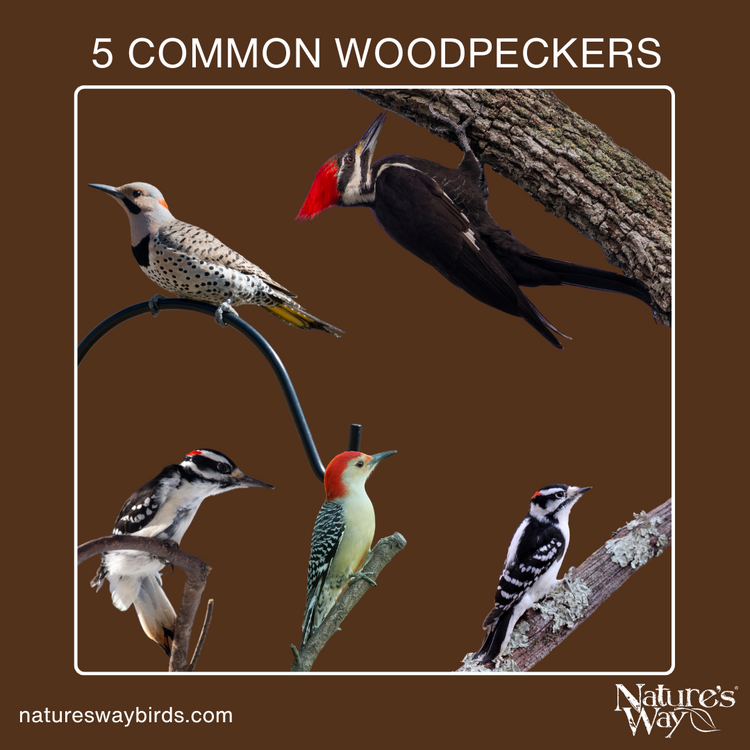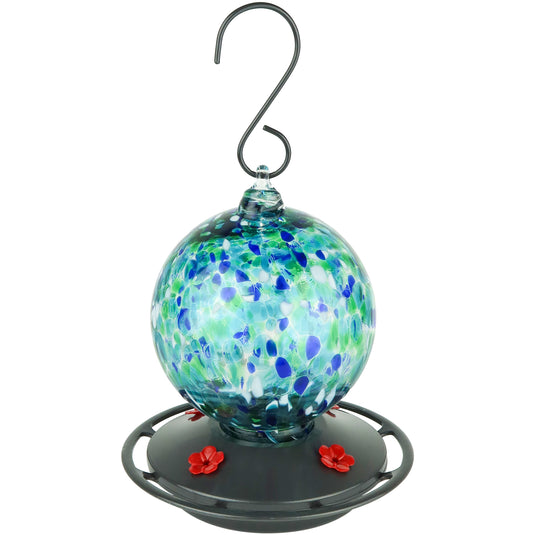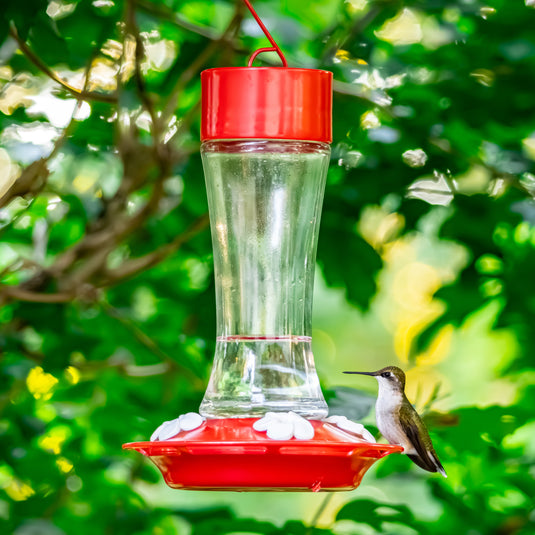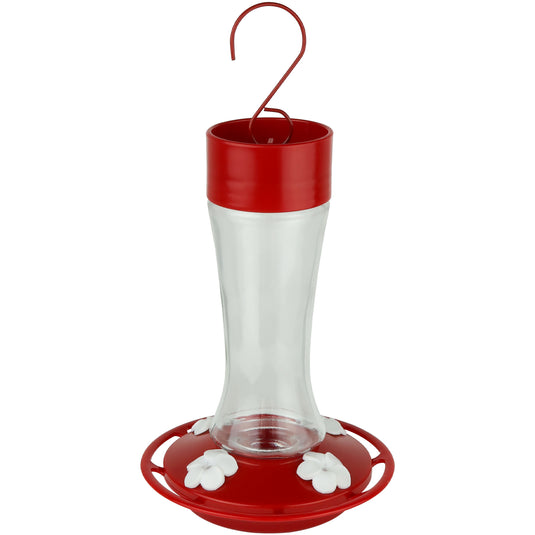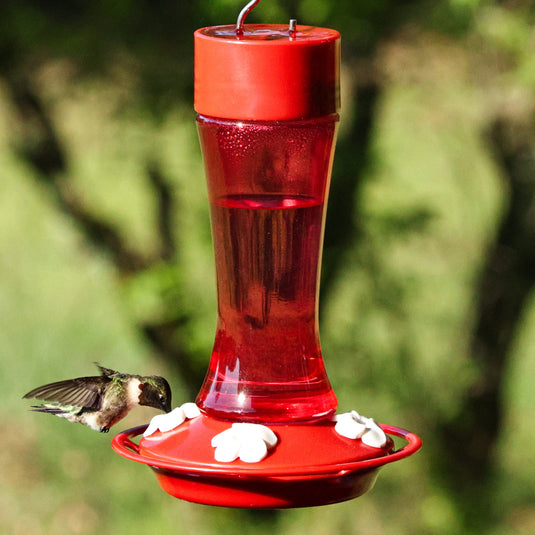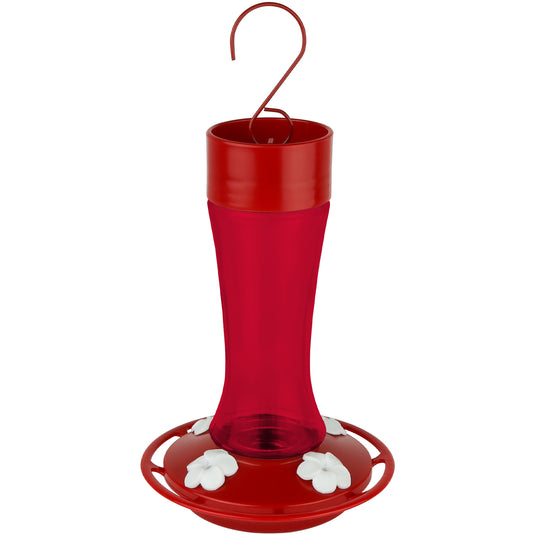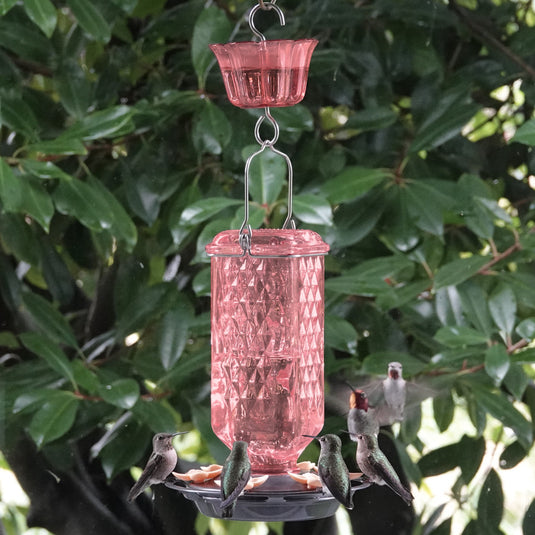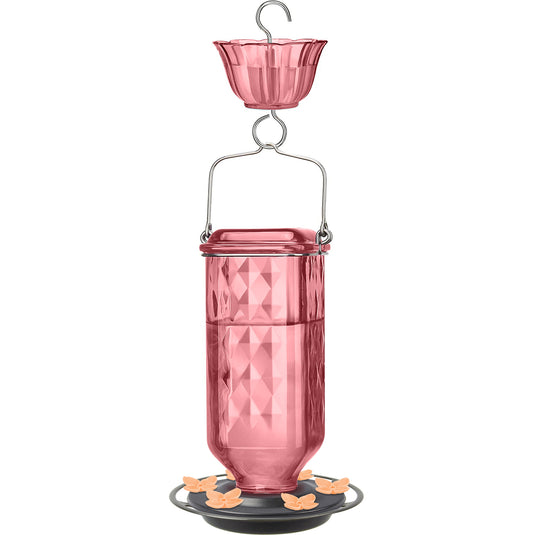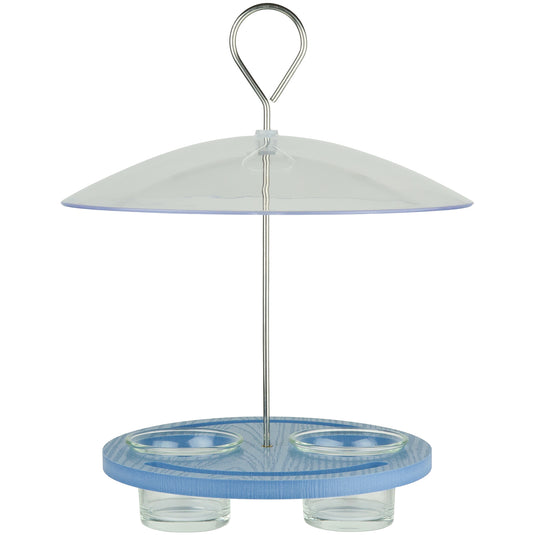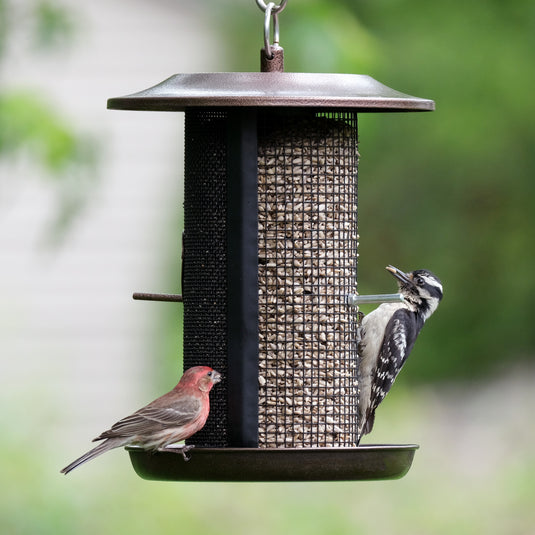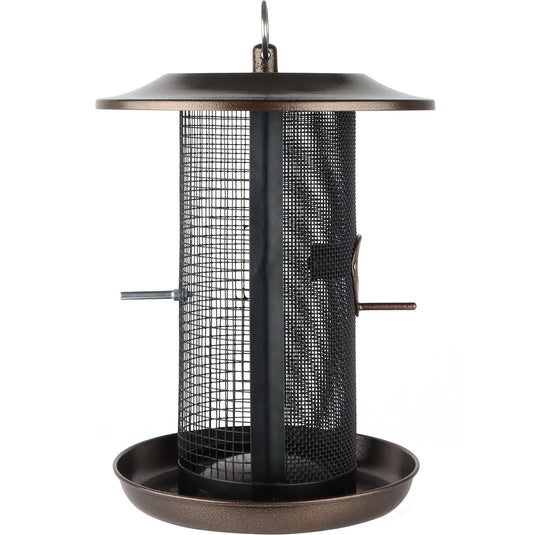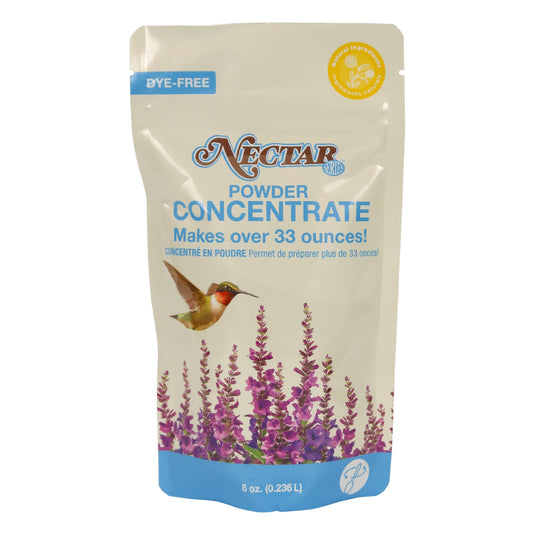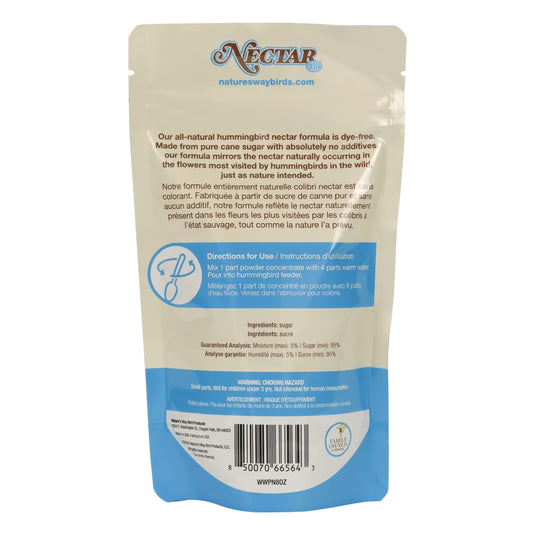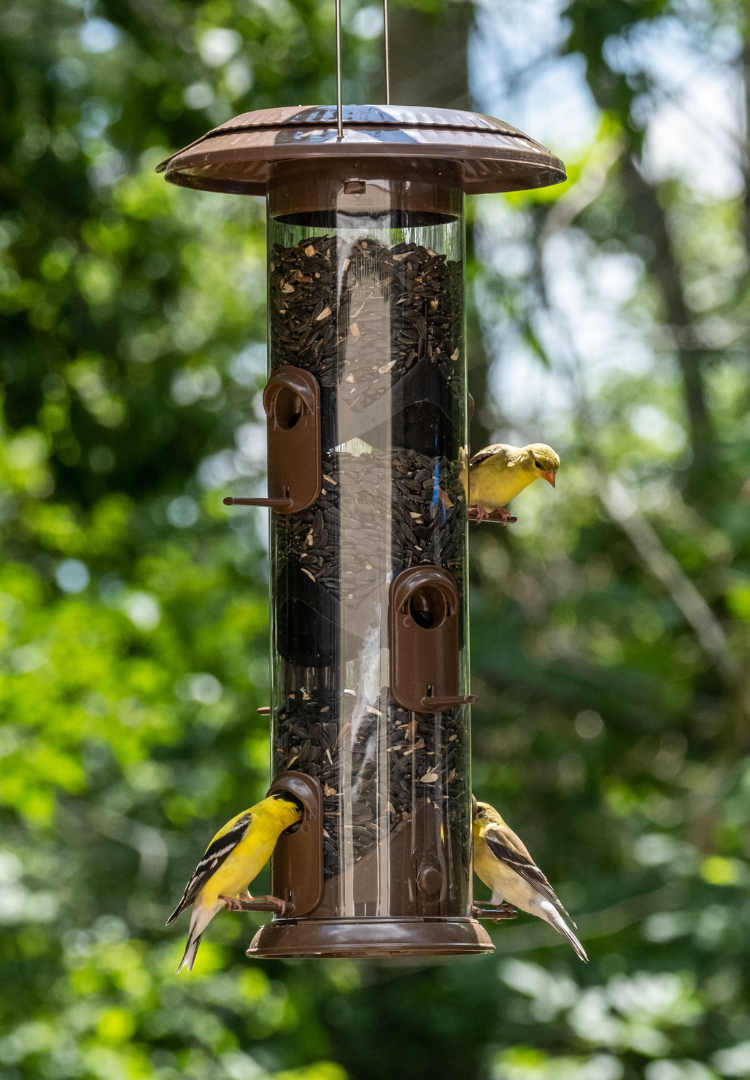Few backyard visitors are as striking or as easy to hear as woodpeckers! From backyards to forests, these birds play an important role in nature while also bringing plenty of excitement to birdwatchers and homeowners alike. In this post, we’ll take a closer look at five of the most common woodpeckers found across the United States and Canada, along with tips to help you tell them apart and even attract them to your yard.
 Pictured: Hairy Woodpecker feeding from Suet Cage Bird Feeder w/ Roof - Four Cake
Pictured: Hairy Woodpecker feeding from Suet Cage Bird Feeder w/ Roof - Four Cake
Red-bellied Woodpecker
Pileated Woodpecker
Northern Flicker
Hairy Woodpecker
Downy Woodpecker
Difference between Hairy and Downy Woodpeckers
How to attract woodpeckers
What do woodpeckers eat?
How to stop woodpeckers from damaging your home
Best bird feeders for woodpeckers
Red-bellied Woodpecker
Identifying Red-bellied Woodpeckers: The Red-bellied Woodpecker, about 9.5 inches long, has a square head, chisel-like bill, and stiff tail for support. Both sexes have a white underside and checkered black-and-white back. Males feature a red stripe from nape to bill, while females have a grayish crown break. Despite its name, its red belly is a faint, often-hidden pinkish patch visible mainly when upside down.


Male Red-bellied Woodpecker (above left) / Female Red-bellied Woodpecker (above right).
Where Red-bellied Woodpeckers live: Red-bellied woodpeckers are commonly found across the eastern United States. Their range extends from the Atlantic Coast, including states like New York and Florida, to the Midwest, covering areas like Ohio, Illinois, and Missouri, and as far west as Texas and Oklahoma. They are also prevalent throughout the Southeastern states and parts of southern New England.

Pileated Woodpecker
Identifying Pileated Woodpeckers: The Pileated Woodpecker is the largest of all woodpecker species in North America, with a long neck, a striking triangular red crest sweeping back from its head, and a powerful chisel-like bill. It measures 16–19 inches from beak to tail, with a wingspan of 26–29 inches. Both sexes have black bodies with white facial and neck stripes, while males are distinguished by a red cheek stripe.
Even if unseen, their presence is noticeable through distinct signs. Their deep, slow drumming echoes as they chisel into dead trees for insects. The large, rectangular holes they carve into rotting wood are another giveaway. Their loud, "whinnying" calls further reveal their location.


Left: Female Pileated Woodpecker. Right: Male Pileated Woodpecker
Where Pileated Woodpeckers live: Pileated Woodpeckers are found throughout much of North America, primarily in mature forests across Canada, the eastern and southeastern United States, and parts of the Pacific Northwest. These birds are non-migratory and stay in their territories year-round.

Northern Flicker
Identifying Northern Flickers: The Northern Flicker is a large, uniquely colored woodpecker with regional variations. Measuring about 11.5 inches long, it has a slim, rounded head, a slightly downcurved bill, and a long, flared tail that tapers to a point. Its dusty taupe body is adorned with black spots, bars, and crescents, along with a distinctive black bib below the neck.
Eastern flickers have bright yellow undersides on their wings and tail, with males sporting black cheek patches. Western flickers, by contrast, have red-tinted wing and tail undersides, and their males feature red cheek patches.


Above Left: Female Northern Flicker (Yellow Shafted) / Above Right: Male Northern Flicker (Yellow Shafted)


Above Left: Female Northern Flicker (Red Shafted) credit: Eric Ellingson | Macaulay Library / Above Right: Male Northern Flicker (Red Shafted) credit: Matt Davis | Macaulay Library
Where Northern Flickers live: Northern Flickers are found across North America, from southern Canada to the northern United States, and throughout most of the U.S. and Mexico. They inhabit woodlands, forests, and suburban areas with large trees.
Some Northern Flickers are migratory, especially those in the northern parts of their range. Flickers from colder regions of Canada and the northern U.S. typically migrate southward during the winter, moving to warmer areas in the southern U.S. and Mexico. However, many populations in milder climates, like the southern U.S., remain year-round residents.

Hairy Woodpecker


Left: Female Hairy Woodpecker. Right: Male Hairy Woodpecker
Identifying Hairy Woodpeckers: Hairy Woodpeckers are 7–10 inches long with a chisel-like bill equal in length to their head. They have a square head, a white underside, black upper wings with checkered lower wings, a boldly striped face, and a white back stripe. Their black tail is bordered by white feathers, and males have a red patch on the back of their heads.
Where Hairy Woodpeckers live: They are found year-round across most of the U.S. and Canada, with northern birds being larger. Western birds have less wing spotting and narrower facial stripes, while eastern birds have bold contrasts. Pacific Northwest populations appear brownish, resembling a coffee-stained look.

Downy Woodpecker


Left: Female Downy Woodpecker. Right: Male Downy Woodpecker
Identifying Downy Woodpeckers: The smallest woodpecker in North America, the Downy Woodpecker measures 5.5–6.7 inches, has a compact build with a short, chisel-like bill, blocky head, and broad shoulders. Despite its small bill, it effectively extracts insects from trees. Both sexes feature a black-and-white checkered pattern, white underside, boldly striped face, and a white back stripe. Their black tail has white-edged feathers, often speckled with black. Males are distinguished by a red patch on the back of the head.
Where Downy Woodpeckers live: Downy Woodpeckers are found throughout North America, from Alaska and Canada to the southern United States. They inhabit a wide range of environments, including deciduous forests, woodlands, orchards, parks, and suburban areas with trees. They are year-round residents across most of their range, though some may move slightly southward in winter.

What is the difference between Hairy and Downy Woodpeckers?
Downy Woodpeckers are roughly two-thirds the size of Hairy Woodpeckers. Since this can be fairly hard to establish in the field, some birders use their feeders as indicator of size and scale. Another establishing feature of the Downy Woodpecker are distinguishable black bars on the white tail feathers in contrast to the all-white side tail feathers of the Hairy Woodpecker. If the bird's bill is visible, the major difference in bill size. The Downy’s bill is roughly one-third the length of the bird’s head, while the Hairy’s bill is almost as long as its head - a railroad spike in comparison. An additional, less reliable distinguishing feature is that the male Hairy Woodpecker's red patch is often split in two, while the Downy’s is not.

How can I attract woodpeckers to my backyard?
To attract woodpeckers to your yard, provide the right combination of food, shelter, and a welcoming environment. Choosing the right feeder is key - suet feeders and wire mesh peanut feeders allow woodpeckers to cling naturally while eating, while sturdy hopper and platform feeders can also work for seeds like black oil sunflower and peanuts. Water is another important factor - a birdbath with fresh water will attract woodpeckers for drinking and bathing.

Pictured: Northern Flicker feeding from Suet Station Recycled Plastic Tail-prop Bird Feeder
Creating a safe environment is essential to keeping woodpeckers coming back. Avoid using pesticides, as woodpeckers rely on insects for food. Consider alternatives like insect houses to control pests and add more beneficial insects to your yard. Providing natural shelter will make your yard more inviting. Leaving dead or dying trees (snags) standing gives woodpeckers a place to forage and nest. By combining these elements, you can make your yard a woodpecker-friendly haven and enjoy watching these fascinating birds up close.
What do woodpeckers eat?
Offering suet is the best way to draw in woodpeckers, as it’s a favorite food source, but peanuts, bark butter, black oil sunflower seeds, mealworms, and fruit like oranges and apples can also be highly appealing. In summer months, it is not unusual to see woodpeckers visiting oriole feeders with grape jelly or even hummingbird feeders with nectar!

Pictured: Red-bellied Woodpecker, Northern Cardinal and Baltimore Oriole feeding from Hanging Platform Feeder
How do I stop woodpeckers from damaging my home?
If woodpeckers are damaging your home, they are likely searching for food, creating a nesting site, or drumming to establish their territory. The first step in deterring them is to remove any potential attractions. Check for insect infestations, such as carpenter ants or termites, as woodpeckers often peck at homes to find food. Sealing any existing holes or cracks can also prevent further damage.
Providing alternative food sources can redirect their attention. Setting up a bird feeder away from your home may give them a more appealing option. Choosing the right feeder is key - suet feeders and wire mesh peanut feeders allow woodpeckers to cling naturally while eating, while sturdy hopper and platform feeders can also work for seeds like black oil sunflower and peanuts.
What are the best bird feeders for woodpeckers?
Offering a variety of foods is key to attracting woodpeckers. While suet is a favorite, they also enjoy peanuts, bark butter, black oil sunflower seeds, mealworms, and fruits such as oranges and apples.
Suet Feeders: Designed specifically for holding suet cakes, these feeders allow woodpeckers to cling while feeding.
Wire Mesh Peanut Feeders: Ideal for offering whole or shelled peanuts, providing a natural clinging surface for woodpeckers.
Hopper Feeders: A sturdy option that can hold a variety of seeds, including black oil sunflower seeds and peanuts.
Platform Feeders: Open and spacious, these feeders allow woodpeckers to access seeds and nuts easily.
Window Feeders: Attached directly to windows, these feeders provide a close-up view of woodpeckers while offering seeds, nuts, or suet.
RELATED ARTICLES
How to create a bird feeding station

